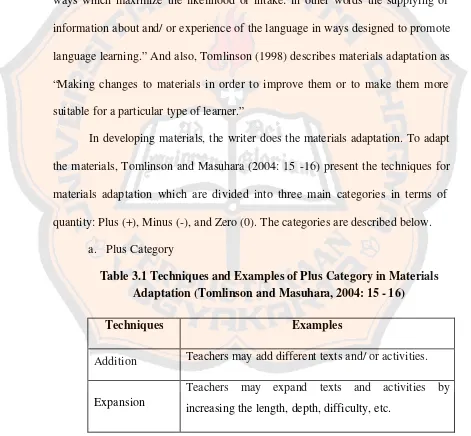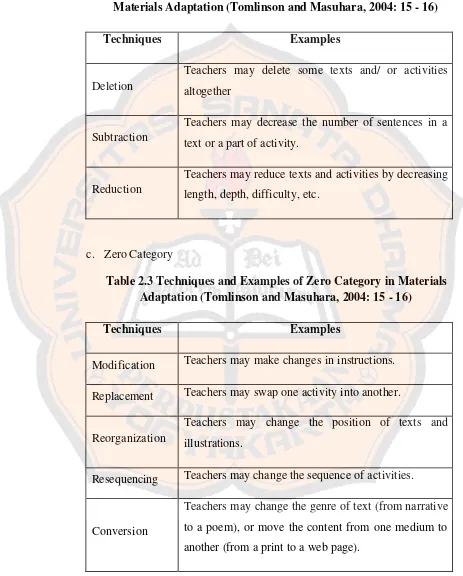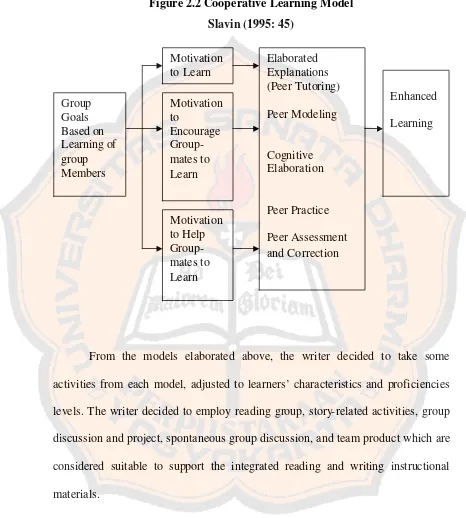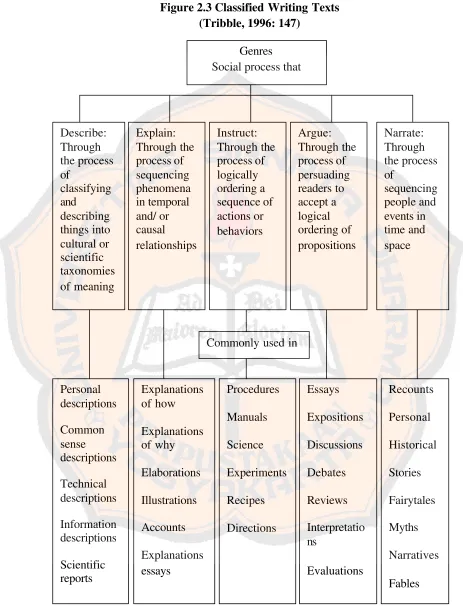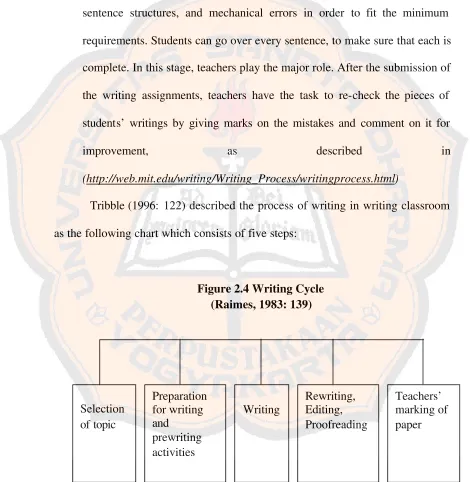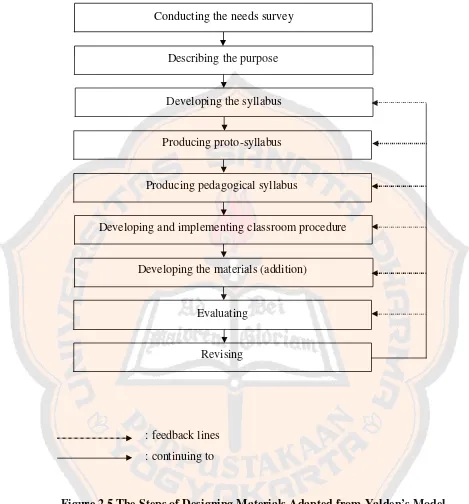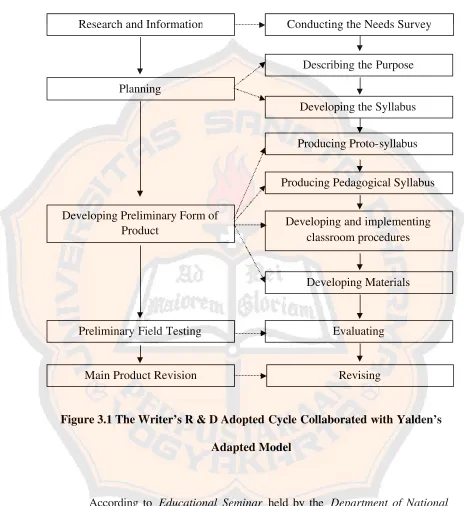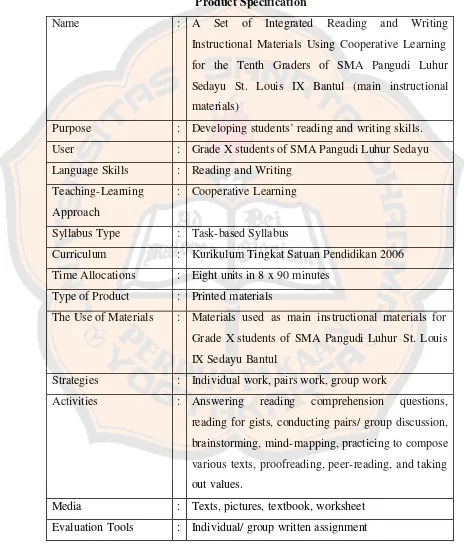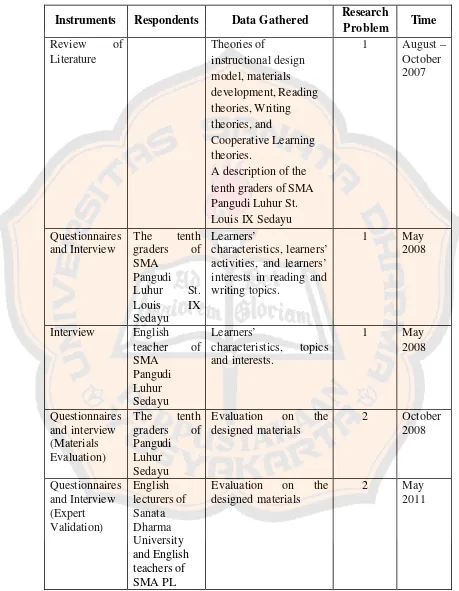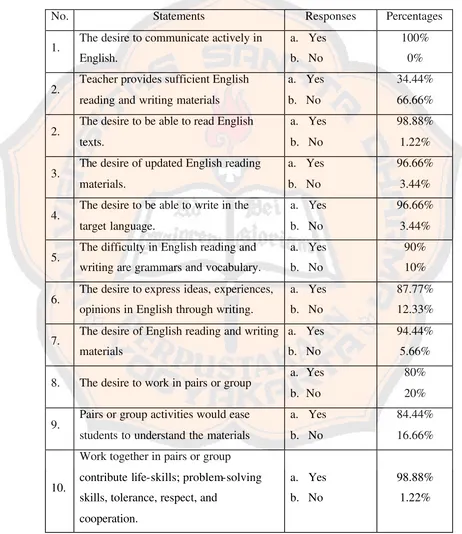A SET OF INTEGRATED READING AND WRITING
INSTRUCTIONAL MATERIALS USING COOPERATIVE LEARNING FOR THE TENTH GRADERS
OF SMA PANGUDI LUHUR ST. LOUIS IX SEDAYU BANTUL
A THESIS
Presented as Partial Fulfillment of the Requirements to Obtain the Sarjana Pendidikan Degree
in English Language Education
By
Kristina Andang Wijayanti
Student Number: 031214020
ENGLISH LANGUAGE EDUCATION STUDY PROGRAM DEPARTMENT OF LANGUAGE AND ARTS EDUCATION
FACULTY OF TEACHERS TRAINING AND EDUCATION SANATA DHARMA UNIVERSITY
ii
A Thesis on
A SET OF INTEGRATED READING AND WRITING
INSTRUCTIONAL MATERIALS USING COOPERATIVE LEARNING FOR THE TENTH GRADERS
OF SMA PANGUDI LUHUR ST. LOUIS IX SEDAYU BANTUL
Prepared and presented by
KRISTINA ANDANG WIJAYANTI
Student Number: 031214020
Approved by
Dr. Retno Muljani, M.Pd. Sponsor
iii
A Thesis on
A SET OF INTEGRATED READING AND WRITING
INSTRUCTIONAL MATERIALS USING COOPERATIVE LEARNING FOR THE TENTH GRADERS
OF SMA PANGUDI LUHUR ST. LOUIS IX SEDAYU BANTUL
By
KRISTINA ANDANG WIJAYANTI
Student Number: 031214020
Defended before the Board of Examiners on July 14, 2011
and Declared Acceptable
Board of Examiners
Chairperson : C. Tutyandari, S.Pd., M.Pd. ______________________
Secretary : Made Frida Yulia, S.Pd., M.Pd. ______________________
Member : Dr. Retno Muljani, M.Pd. ______________________
Member : Ag. Hardi Prasetyo, S.Pd., M.A. ______________________
Member : Dr. Ant. Herujiyanto, M.A. ______________________
Yogyakarta, July14, 2011
Faculty of Teachers Training and Education Sanata Dharma University
Dean,
iv
To my beloved parents, siblings, and
Ramak
To my beloved and extended family
v
STATEMENT OF WORK’S ORIGINALITY
I honestly declare that this thesis, which I have written, does not contain the work
or parts of the work of other people, except those cited in the quotations and the
references, as a scientific paper should.
Yogyakarta, June 17th 2011 The Writer
Kristina Andang Wijayanti
vi ABSTRACT
Wijayanti, Kristina Andang. 2011. A Set of Integrated Reading and Writing Instructional Materials Using Cooperative Learning for the Tenth Graders of SMA Pangudi Luhur St. Louis IX Sedayu Bantul. Yogyakarta: English Language Education Program, Sanata Dharma University.
As a foreign- international language, English has been taught in Indonesian schools for years. At the end of the learning processes, students are expected to be able to communicate in the target language. To communicate in the target language is not only by speaking. To communicate could be in the form of writing. Unfortunately, writing as a form of communication using verbal symbols is neglected due to its complex and recursive processes during the teaching and learning activities. Beyond the thoughts, there were many students desired to have good reading and writing skills while there were hardly integrated reading and writing materials. By having the experiences as a teacher in SMA Pangudi Luhur St. Louis IX Sedayu Bantul, the writer attempts to provide the tenth grade students a set of integrated reading and writing materials by using the Cooperative Learning strategy to meet their needs in such learning materials. It was expected that the designed materials would foster the language learning and students would obtain both academic and social skills (e.g. problem-solving, tolerance, respect, etc.). Further, it was also expected that the students would have meaningful and experiential learning.
There were two problems formulated in the study. The problems were (1) How is a set of integrated reading and writing instructiona l materials for the tenth graders of SMA Pangudi Luhur St. Louis IX Sedayu Bantul designed? and (2) What does the designed instructional materials look like?
To answer the first problem, the writer carried out some steps on Educational Research and Development (R & D) method which were combined with adapted steps from Yalden’s model which had been adjusted with the research. The steps combined from those two steps were (1) reviewing the literature, (2) conducting the needs survey, (3) describing the purposes, (4) developing the syllabus, (5) producing proto-syllabus, (6) producing pedagogical syllabus, (7) developing and implementing classroom procedures, (8) developing materials, (9) evaluating the designed materials, and (10) revising the designed materials.
vii
two English teachers and also the tenth grader students of SMA Pangudi Luhur St. Louis IX Sedayu Bantul. To describe the evaluation results, the writer used percentages and qualitative data analysis. The data showed that the designed materials were acceptable and desired by English teachers of SMA Pangudi Luhur St. Louis IX Sedayu Bantul as the instructional materials applied for teaching and learning activities. Some suggestions and evaluation of the designed materials evaluation then were the bases to revise the designed materials before truly applied in classroom.
Then, the presentation of the final version of the designed materials was to answer the second research problem. The designed set of integrated reading and writing instructional materials using Cooperative Learning for the tenth graders of SMA Pangudi Luhur St. Louis IX Sedayu Bantul consists of eight units, namely,
Meaningful Words, Hey! I Have a Good Map!, Be Aware of Simple Things!, Love, Live, Wisdom, Share the Love, Life, Wisdom, I Know U Know We Know (‘Coz U’ve Shared Me!), Scrap and Scratch!, and Cheapy-Speedy-Friendly!.
viii
ABSTRAK
Wijayanti, Kristina Andang. 2011. A Set of Integrated Reading and Writing Instructional Materials Using Cooperative Learning for the Tenth Graders of SMA Pangudi Luhur St. Louis IX Sedayu Bantul. Yogyakarta: Program Studi Bahasa Inggris, Universitas Sanata Dharma.
Sebagai bahasa asing internasional, Bahasa Inggris telah diajarkan di hampir semua sekolah-sekolah di Indonesia selama bertahun-tahun. Pada akhir kegiatan belajar dan mengajar, siswa diharapkan untuk mampu berkomunikasi dalam Bahasa Inggris. Berkomunikasi tidak hanya dalam bentuk berbicara. Berkomunikasi dalam Bahasa Inggris bisa dalam bentuk menulis. Sayangnya, menulis sebagai bentuk komunikasi dengan menggunakan simbol-simbol verbal cenderung diabaikan karena kerumitan prosesnya sebagai kegiatan belajar dan mengajar di kelas. Di luar dugaan, ada banyak siswa yang berkeinginan untuk mempunyai kemampuan membaca dan menulis dalam Bahasa Inggris dengan baik tetapi hampir tidak ada materi membaca dan menulis yang terintegrasi. Dengan memiliki pengalaman sebagai guru di SMA Pangudi Luhur St. Louis IX Sedayu Bantul, penulis mencoba menyediakan seperangkat materi membaca dan menulis yang terintegrasi dengan menggunakan strategi Cooperative Learning untuk memenuhi kebutuhan siswa kelas X. Penulis berharap agar desain materi membaca dan me nulis yang terintegrasi akan dapat meningkatkan kemampuan siswa dalam berbahasa Inggris serta siswa juga akan memperoleh kemampuan sosial seperti penyelesaian masalah, toleransi, dan saling menghormati. Selanjutnya, siswa juga diharapkan memperoleh kegiatan belajar yang penuh pengalaman berarti.
Ada dua rumusan masalah dalam penelitian ini. Rumusan masalah tersebut adalah (1) Bagaimana seperangkat materi membaca dan menulis yang terintegrasi untuk siswa-siswi kelas X di SMA Pangudi Luhur St. Louis IX Sedayu Bantul dirancang? dan (2) Bagaimana penyajian seperangkat materi membaca dan menulis yang terintegrasi yang telah tersusun?
ix
Dalam penelitian ini, data diperoleh dari survei kebutuhan. Hasil dari survei kebutuhan yang berupa karakter siswa, minat, jenis kegiatan belajar dan keinginan akan materi pembelajaran merupakan dasar untuk menyusun materi. Setelah selesai, materi yang telah tersusun dievaluasi oleh beberapa dua dosen dari Pendidikan Bahasa Inggris Universitas Sanata Dharma , dua orang guru Bahasa Inggris dari SMA Pangudi Luhur St. Louis IX Sedayu Bantul berikut para siswa-siswi kelas X. Pemaparan evaluasi tersebut disajikan dalam bentuk prosentase. Sebagai tambahan, penulis juga menggunakan analisis data kualitatif untuk memaparkan hasil evaluasi. Dari data yang diperoleh dari tahap evaluasi, materi yang telah tersusun diterima dan diinginkan supaya dapat dipergunakan dalam kegiatan belajar dan menga jar di SMA Pangudi Luhur St. Louis IX Sedayu Bantul. Beberapa saran dan evaluasi untuk perbaikan dari materi yang telah tersusun menjadi landasan untuk memperbaiki materi agar bisa dipergunakan dalam proses belajar dan mengajar di SMA Pangudi Luhur St. Louis IX Sedayu Bantul.
Presentasi materi versi akhir merupakan jawaban dari rumusan masalah kedua. Seperangkat materi membaca dan menulis yang terintegrasi terdiri dari delapan unit, yaitu Meaningful Words, Hey! I Have a Good Map!, Be Aware of Simple Things!, Love, Live, Wisdom, Share the Love, Life, Wisdom, I Know U Know We Know (‘Coz U’ve Shared Me!), Scrap and Scratch!, dan Cheapy-Speedy-Friendly!. Tiap unit dari materi terdiri dari tiga bagian aktivitas. Bagian – bagian tersebut adalah Pre-activities, Main Activities, dan Post-activities.
x
LEMBAR PERNYATAAN PERSETUJUAN
PUBLIKASI KARYA ILMIAH UNTUK KEPENTINGAN AKADEMIS
Yang bertanda tangan di bawah ini, saya mahasiswa Universitas Sanata Dharma:
Nama : Kristina Andang Wijayanti
Nomor Mahasiswa : 031214020
Demi pengembangan ilmu pengetahuan, saya memberikan kepada Perpustakaan
Universitas Sanata Dharma, karya ilmiah saya yang berjudul:
A SET OF INTEGRATED READING AND WRITING INSTRUCTIONAL MATERIALS USING COOPERATIVE LEARNING FOR THE TENTH GRADERS OF SMA PANGUDI LUHUR ST. LOUIS IX SEDAYU BANTUL
Beserta perangkat yang diperlukan (bila ada). Dengan demikian saya memberikan
kepada Perpustakaan Universitas Sanata Dharma hak untuk menyimpan,
mengalihkan dalam bentuk media lain, mengelolanya dalam bentuk pangkalan
data, mendistribusikan secara terbatas, dan mempublikasikannya di internet atau
media lain untuk kepentingan akademis tanpa perlu meminta ijin dari saya
maupun memberikan royalti kepada saya selama tetap mencantumkan nama saya
sebagai penulis.
Demikian pernyataan ini saya buat dengan sebenarnya.
Dibuat di Yogyakarta
Pada tanggal: 17 Juni 2011
Yang menyatakan,
xi
ACKNOWLEDGMENTS
For the years I had through, I would like to express my gratitude to the
following persons for any help which I could never repay.
Firstly, my deepest gratitude is always to Lord Jesus Christ, Mother Mary, and My Guardian Angel for every blessing, strength, and companion.
Secondly, I address my sincere gratitude to my beloved parents, Bapak Michael Sugita and Ibu Bernadeta Sarjinem, for the unconditional love, supports, and guidance. My siblings; Rufina Andang, Adriana Andang,
Constantius Damar, and Nicholas Dian for letting me to be your ignorant sister. I love and am happy to be with you as my family. I also thank my future in- laws;
Apresian Risadi and Yohanes Novendriono for the friendship. In addition, I thank Albertus Agung for the days we share together. God bless you all.
Thirdly, I warmly thank Ibu Dr. Retno Muljani, M.Pd., as my thesis sponsor for her incredible patience and willingness to share her expertise and
knowledge. I also thank my former thesis sponsor, Ibu Yohana Veniranda, S.Pd., M.Hum., for her patience. In addition, I am deeply grateful to Ibu Caecilia Tutyandari, S.Pd., M.Pd., Bapak Agustinus Prasetyo Hardi, S.Pd., M.A., and all Lecturers of English Language Education Program of Sanata Dharma University for being my teachers with everything you had taught me. I also thank
xii
Fourth, I would like to address my deep gratitude to Yayasan Pangudi Luhur Yogyakarta and Semarang, Teachers, Staff and Students of SMP Pangudi Luhur Santo Paulus Moyudan, SMP Pangudi Luhur St. Vincentius Sedayu, and SMA Pangudi Luhur St. Louis IX Sedayu for sharing me the opportunities to learn and to grow with the students. I deeply thank Ibu Erna and
Pak Bambang as the English teachers of SMA Pangudi Luhur St. Louis IX for sharing me their classes to conduct my research activities.
Fifth, I address my sincere thank to my incredible friends in PBI USD
2003; Ratri, Layung, Ayu, Monci, Lukas, Yessi, Retha, Ignaz, Lexi, and those who I could not mention here. I owe you the beautiful stories of PBI 2003 classes,
courses, play performances, SPD, and sincere friendships.
Sixth, I thank my fabulous friends in PPA Plus; Deni, Satria, Fendi, Andi, Agung, Eko, Sugeng, Tami, Imma, and Rinto for coloring my life with our friendships, laughs, warmth, and your supports.
Lastly, I address my respect and gratitude to Romo Patrick Joseph Barry, MBS., Romo FX. Murdisusanto, Pr., Romo P. Martasudjita, Pr.,
Romo EM. Supranowo, Pr., and Mgr. Y. Pujasumarta for your prayers and advices. I would always be thankful for the opportunities to take my part in my
little service to Jesus.
xiii
TABLE OF CONTENTS
TITLE PAGE ……… i
APPROVAL PAGES ………. ii
DEDICATION PAGE ………... iv
STATEMENT OF WORK’S ORIGINALITY ……….. v
ABSTRACT ………... vi
ABSTRAK ………... viii
PUBLICATION PAGE………. x
ACKNOWLEDGEMENTS……… xi
TABLE OF CONTENTS ………. xiii
LIST OF TABLES ………. xvii
LIST OF FIGURES ………... xviii
LIST OF APPENDICES ……… xix
CHAPTER I. INTRODUCTION
A. Research Background ………...
B. Problem Formulation ………
C. Problem Limitation ………..
D. Research Objectives ……….
E. Research Benefits ……….
F. Definition of Terms ……….. 1
5
6
7
7
xiv CHAPTER II. THEORETICAL REVIEW
A. Theoretical Descriptions
1. Teaching and Learning ………..
2. Yalden’s Instructional Design ……….
3. Materials Development ………
4. Cooperative Learning
a. Theories and Principles ………...
b. Characteristics ………..
c. Models ………..
d. Objectives ……….
e. The Roles of Learners and Teachers ………
5. Reading
a. The Nature of Reading ………...
b. The Principles of Teaching Reading ………..
c. Types of Reading ………..
d. Reading Activities ……….
e. Reading Techniques ……….
f. Genres ………
6. Writing
a. The Nature of Writing ………..
b. The Principles of Teaching Writing ……….
c. Purposes of Writing ………..
d. Writing Processes ………..
e. Types of Writing ………
f. Good Writing ……….
7. Integrated Reading and Writing ………..
8. The Tenth Grade of SMA Pangudi Luhur St. Louis IX Sedayu
Bantul ………..
xv CHAPTER III. METHODOLOGY
A. Research Method ………
1. Research and Information Collection ………...
2. Planning ………
3. Developing Preliminary Form of Product ……….
4. Preliminary Field Testing ………..
5. Main Product Revision ……….
B. Research Participants ………...
C. Research Instruments ………
a. Questionnaire Sheet ………...
b. Interview Guidelines ……….
D. Data Gathering Technique ………
E. Data Analysis Technique ………...
F. Research Procedure ……….. 64
CHAPTER IV. RESEARCH RESULTS AND DISCUSSIONS
A. The Steps in Designing the Materials ………...
a. Reviewing the Literature ………...
b. Conducting the Needs Survey ………...
c. Describing Purposes ………..
d. Developing the Syllabus ………
xvi
f. Producing Pedagogical Syllabus ………...
g. Developing and Implementing Classroom Procedures ………….
h. Developing the Materials ………..
i. Evaluating the Designed Materials ………
j. Revising the Designed Materials ………...
B. The Presentations of the Designed Materials ………... 92
93
96
97
108
109
CHAPTER V. CONCLUSIONS AND SUGGESTIONS
A. Conclusions ………..
B. Suggestions ………... 117
118
xvii
LIST OF TABLES
Table 2.1 Techniques and Examples of Plus Category ………
Table 2.2 Techniques and Examples of Minus Category ………
Table 2.3 Techniques and Examples of Zero Category ………..
Table 3.1 Product Specification of the Designed Materials …………
Table 3.2 The Whole Process of Data Collecting ………
Table 4.1 Summary of the Learners’ Questionnaires ……….
Table 4.2 Summary of the Respondents’ Interviews ………..
Table 4.3 Summary of Teachers’ Interviews ………...
Table 4.4 The Topics of the Designed Materials ……….
Table 4.5 The Learning Materials of the Designed Materials ……….
Table 4.6 The Learning Indicators ………
Table 4.7 The Words in the Designed Materials ……….
Table 4.8 Results of the Expert Validations ………
Table 4.9 Results of the Expert Validations in Percentages ………...
Table 4.10 The Strengths and the Weaknesses of the Designed Materials
Table 4.11 Results of Students’ Evaluation ……….
Table 4.12 Results of Students’ Evaluation in Percentages …………
Table 4.13 The Presentation of the Designed Materials ……….
xviii
LIST OF FIGURES
Figure 2.1 Yalden’s Adapted Model ……….
Figure 2.2 Cooperative Learning Model ………..
Figure 2.3 Classified Writing Texts ……….
Figure 2.4 Writing Cycle ………..
Figure 2.2 The Steps of Designing Materials Adapted from Yalden’s
Model ………..
Figure 3.1 The Writer’s R & D Adapted Cycle Collaborated with
Yalden’s Adapted Model ………
17
30
46
53
63
xix
LIST OF APPENDICES
Appendix 1 Letters of Permission ………. 124
Appendix 2 Questionnaire for the Needs Analysis ……….. 126
Appendix 3 Evaluation Questionnaires ……… 129
Appendix 4 Questionnaire for Expert Validation ……… 131
Appendix 5 Overview of the Designed Materials ………. 135
Appendix 6 Syllabus and Lesson Plans ……… 138
CHAPTER I INTRODUCTION
This chapter consists of six parts. They are the research background,
problem formulation, problem limitation, research objectives, research benefits,
and definition of terms used in the research.
A. Research Background
As a foreign- international language, English has been taught in Indonesian
schools for years. Students learn English as a compulsory subject in schools. As
an international language, English plays important roles in human
communication. English plays its roles for personal relationships, academic
matters, business, trades, politics, etc. But as a foreign language, English is hardly
used for most Indonesian daily life communication needs. While English is
possibly taught as a painstaking compulsory subject (for the students), at the end
of academic year it only becomes a passport in high-school graduation to continue
to higher education. According to Gebhard (2000: 3),
“In many countries where English is a foreign language, the primary goal for children studying in the educational system is to pass English entrance exams to enter good high schools and universities. As such, much of the teaching is directed at making students able to analyze and comprehend English so they can pass entrance examinations, not necessarily at preparing them to communicate in English. ”
However, as explained by Freeman (2000: 130) “Language is for
communication. At the same time people or students learn languages; they are
expected to be able to communicate in the languages which are being learned.”
From the statement, it could be concluded that communication involved receptive
(listening, reading) and productive (speaking, writing) skills. Receptive skills
mean receiving information in the activities of listening or reading. Productive
skills mean sending information by producing speech (speaking) or texts
(writing).
To communicate is not only in speaking as a productive skill. To
communicate could be in the form of writing. According to Zimmerman and
Rodrigues (1992: 5),
“Writing is a system of communication. Anyone who knows how to speak can learn how to write by learning the sound- symbol correspondence of a given language. But writing is much more than letters put together in meaningful patterns. Writing is a way of thinking, a way of learning, a way of sharing ideas with others. Writing often plays an integral role in an individual’s personal as well as professional life. Writing is a social activity and also a complex, cognitive process.”
But in its practice, writing practice is avoided by many English teachers because
of its complexity. Why? “Writing has various stages of drafting, reviewing,
re-drafting, and writing which are done in a recursive way: we loop backwards and
move forwards between these various stages” (Harmer, 1991: 326). To proofread
students’ writings could be a painstaking job for English teachers. Beyond its
painstaking process for teachers when they proofread students’ writings, students
are possibly desired to be able to read and write in English as the target language
By having the teaching and learning experiences during the
macro-teaching practice and as an assistant- teacher in SMA Pangudi Luhur St. Louis IX
Sedayu, these problems were the real situation of English language teaching and
learning. There were hardly English writing materials since the language learning
focused on reading comprehension which was considered as easier learning
activities. Hence, the instructional materials which meet the students’ needs and
desires in reading and writing were strongly needed. The instructional materials
contain reading and writing as the integrated skills.
Why is it integrated? Pehrsson and Robinson (1985: 3) explain that
“Reading and writing are closely related processes that reflect the organization of
ideas in the minds of readers and writers. Reading is constructive. Individuals
construct and reconstruct their organization of ideas before reading, then
reconstruct again based upon what they know as a result of reading.” Considering
the matter, as a receptive skill and a productive skill, reading and writing support
each other. Readings or texts produced by writers. And, a writer read texts as the
sources of knowledge before sharing ideas, opinions, or experiences.
Therefore, readings would be the texts modeling and the source of
knowledge for the students. Readings as the texts modeling enable students to
comprehend detailed elements to produce writings. As explained by Tiedt (1989:
4 - 5) in the following page,
other students, too, provide models that demonstrate aspects of writing from whic h young writers can learn. ”
However, since students had learned the same texts types (e.g. narratives,
recounts, descriptive, and procedures) with simpler vocabulary in junior
high-school level, senior high-high-school level is suitable for students to start writing. As
the subject of this material is the tenth grade of senior high-school. In addition,
SMA Pangudi Luhur St. Louis IX Sedayu Bantul also conducted several
extracurricular classes in which also included English Club and Journalism Club.
Step up from the facts, the writer attempts to design integrated reading and writing
instructional materials.
As the oars for learning activities is the Cooperative Learning since it
employs both academic and social skills for the students. Cooperative Learning
could be the way to lessen the painstaking processes for both teachers and
students. Cooperative Learning is considered appropriate to enable students work
together to create their experiential and meaningful learning experiences that
might lessen the painstaking processes. Explained Freeman (Jacob, 2000: 164),
“In cooperative learning, teacher helps students learn how to learn more effectively. Teachers teach students collaborative or social skills that they can work together more effectively. Cooperation is not only a way of learning, but also a theme to be communicated about and studied.”
There are values to grasp at the end of learning through cooperative learning. The
values are taken from discussion, group- task management, working out the
characters, proficiencies, interests, and thoughts differences among them. Through
cooperative learning, students are expected to go further in a discourse
In short, the reasons for the decision to design a set of integrated reading
and writing material for the tenth grade are based on three considerations. First,
was to foster the language teaching in SMA Pangudi Luhur St. Louis IX Sedayu
Bantul, especially in reading and writing skills. Second, was to design an
instructional material which contributes both academic and social skills for our
lives (e.g. problem solving skills, tolerance, and respect) through the Cooperative
Learning strategy. Third, the writer discovered that many students desire to be
able to read and write in English through simple and understandable materials.
Therefore, the materials are designed as the guidelines for students to develop
reading and writing skills in English as the target language.
Added to the previous paragraph, by designing a set of integrated reading
and writing instructional materials for the tenth grade of senior high-school, the
writer expects the materials would be fruitful for both teachers and students.
B. Problem Formulation
In the research, there are two main problems that the writer is going to
solve. The two problems can be formulated as follows:
1. How is a set of integrated reading and writing materials using cooperative
learning for the tenth graders of SMA Pangudi Luhur St. Louis IX Sedayu
Bantul designed?
2. What does the designed set of integrated reading and writing instructional
materials using Cooperative Learning for the tenth graders of SMA Pangudi
C. Problem Limitation
The research is limited to the discussion on designing a set of integrated
reading and writing instructional materials using Cooperative Learning for the
tenth graders of SMA Pangudi Luhur St. Louis IX Sedayu Bantul. As described in
the research background, there are three reasons why the writer chooses reading
and writing as integrated materials as her research objects. First, was to foster the
language teaching in SMA Pangudi Luhur St. Louis IX Sedayu Bantul, especially
in reading and writing skills. Second, was to design an instructional material
which contributes both academic and social skills for our lives (e.g. problem
solving skills, tolerance, and respect) through the Cooperative Learning strategy.
Third, the writer discovered that many students desire to be able to read and write
in English through simple and understandable materials.
The tenth grade is considered as a perfect stage where students could start
developing productive skills, especially writing. Most students in the tenth grade
had studied the same reading text types (e.g. narratives, recounts, descriptive, and
procedures) in their previous academic level, junior high-school. During the
previous academic level, the tenth grade students had learned the generic
structures and the language features. Then, in the tenth grade, it would be better to
produce each text type as a productive skill. Thus, it can be understood why the
research is designed for the tenth grade of SMA Pangudi Luhur Sedayu St. Louis
IX Bantul.
Reading activities will be the paths for students to produce the same texts
students also practice to write by formulating ideas from what they read. Then,
writing is their products of the target language. However, due to the limited
knowledge of the writer, the designed materials were no t fully integrated the
reading and writing materials. Some units consist of only reading or writing
materials.
D. Research Objectives
Considering the problems which have been stated in the problem
formulation, the research is conducted to achieve the following objectives:
1. to design how a set of integrated reading and writing instructional materials
using cooperative learning for the tenth graders of SMA Pangudi Luhur St.
Louis IX Sedayu Bantul.
2. to present the designed set of integrated reading and writing instructional
materials using Cooperative Learning for the tenth graders of SMA Pangudi
Luhur St. Louis IX Sedayu Bantul
E. Research Benefits
There are obstacles, complication, and hindrance during this work
completion. Therefore, the writer really hopes that this work could be very helpful
and useful for these followings:
Since there are limited similar designs which focused on writing skills, the
writer also hopes that this work could be her contribution to other researchers,
designers, and readers.
2. For the other teachers and future teachers
The writer hopes that this work could be one of the sources in developing
reading and writing skills of senior high school students.
3. For the tenth graders ofSMA Pangudi Luhur St. Louis IX Sedayu Bantul
The writer hopes that this work could be the facility to practice writing skills
further because writing is written communication. The writer also hopes that
the students’ reading skills could be improved through the integrated materials
4. For the readers, researchers, and other designers
The writer hopes that someday, this work could be the reference to do the
research, design, and the sources to read and broaden the view about English
language skills. Since there are less writing materials references for new
designers, the writer hopes that this work could help them provide important
designing references.
F. Definitions of Terms
There are seven key terms which are used in this research, they are:
1. Design
Based on Oxford Learner’s Dictionary (1995: 314) design is a “drawing or
an outline from which something may be made”. Meanwhile, Trochim (2006)
major parts of the research project… work together to try to address the central
research questions.” Here, design is a plan which is mentioned to facilitate
intended subject that the tenth graders of senior high-school to help them develop
reading and writing skills.
The designed materials are integrated. As derived from Longman
Dictionary of Contemporary English, integrated is to combine many different
groups, ideas, or parts in a way that works well and effective.
2. Integrated Reading and Writing Materials
According to Brown (2007: 286), “Production and reception are quite
simply two sides of the same coin; one cannot split the coin in two. Interaction
means send and receiving messages.”
According to Nuttal (1982: 23) as cited in Siswardhana (2002: 19),
“Reading is explained as the meaningful interpretation of printed or written verbal
symbols. Reading is the activity of obtaining information from written sources;
articles, newspapers, magazines, books, etc. Reading is a cognitive activity where
students obtain the information by analyzing and comprehending the written
sources.”
According to Tiedt (1989: 1), “Writing is a method of expressing ideas
about any subject content; it appears in classroom everywhere and, therefore,
must be the concern of every teacher. Writing skills is then, the ability and
sufficient experiences, and background knowledge to perform writing activities in
order to construct good paragraph in meeting the minimum requirements
In this study, reading and writing are integrated because it relates and supports
one another. Reading is to provide models and sources, while writing is to
produce written knowledge. Integrated reading and writing materials were the
designed materials which provided both reading and writing activities at the same
time of learning.
3. Cooperative Learning
According to Slavin (1995: 2), “Cooperative learning is a variety of
teaching methods in which students work in small groups to help one another
learn academic content. In cooperative classrooms, students are expected to help
each other, to discuss and argue each other, to access each other’s current
knowledge and fill in gaps in each other’s understandings.”
4. The Tenth Grade of SMA Pangudi Luhur St. Louis IX Sedayu Bantul
SMA Pangudi Luhur St. Louis IX Sedayu is one of private schools in
Daerah Istimewa Yogyakarta which hold by the FIC Brothers in Yayasan Pangudi
Luhur Semarang. The aim of this Catholic school is to provide education for
young generations with values. The school is located at Jalan Wates Km. 14
Argosari Sedayu Bantul. The tenth is a stage where the students are in the age of
15 – 17 years old. The tenth grade is divided into four classes which based its
CHAPTER II
REVIEW OF RELATED LITERATURE
There are two major sections that are going to be discussed in this chapter.
They are the theoretical descriptions which contain reviews on related literatures
to answer research problems and the theoretical framework which underlies the
research.
A. Theoretical Descriptions
In this section, the writer elaborates seven groups of theory which will be
used to design a set of integrated reading and writing instructional materials for
the tenth graders of SMA Pangudi Luhur Sedayu St. Louis IX Bantul. Those are
the theory of teaching and learning, the theory of instructional design, the theory
of materials development, the theory of Cooperative Learning, the theory of
reading, the theory of writing, the theory of integrated reading and writing.
1. Teaching and Learning
Teaching and learning reflects one another. Teaching and learning are the
synergy between teachers and students, so forth. Teachers teach various characters
of students. To teach means to draw our willingness to respect each character
based on humanity. To teach means to bridge our students to broader views and
unlimited knowledge. Duncan and Hough (1970: 2) notes that teaching is an
creatively and imaginatively uses himself and his knowledge to promote the
learning and welfare of others.
To teach is to carry double duties, to succeed academic goals and do
parenting. To teach is to provoke students about the everlasting values of learning.
To teach is also to evoke students’ awareness about the tremendous values of
knowledge for life, for others, for the world and humanity.
Teachers are expected to be fair for each student. Capable to manage any
misbehavior may emerge during the classroom activities. The essential point to
consider, teachers are not to choose ideal classrooms or students with certain
proficiencies. Teachers have to be willing to take students what they are. And, to
unify all differences into a meaningful humanity learning processes.
However, a classroom’s activities involved the other party; students. In a
classroom, students experience their learning achievements. According to Gagne
(1997: 3) as cited in Winastuti (1998: 8),
Learning is a change in human disposition or capability, which persists over time, and which is not simply ascribable to processes of growth. Learning must be comprehensive, means that when someone learns a language, it will not only the language elements as the materials to learn, but also the culture and customs that may affect the usage of the language. Through the language they obtain, even in minimum rate, learners may shift their paradigms about one issue or capable in working things out or taking decisions. The knowledge mastery is unseen but obvious in their actions.
From this statement, it is clear that learning is a process which needs to involve a
Thus, the writer bases the designed materials also from the principles of
teaching and the principles of learning. Duncan and Hough (1970: 4- 7) outsets
six teaching principles as below:
a. The teacher is (or must become) a professional who is capable of making
rational, humane, and creative decisions regarding the teaching act.
b. The primary purpose of teaching is to facilitate student learning.
c. Students learning can be measured only through observations that reveal
changes in behavior.
d. The act of teaching is a complex process that is influenced by a field of
forces of which teachers can be only in part aware and which the teacher
can only partially control.
e. Teaching is an activity that can be described and analyzed.
f. Teachers should use objective evidence about their teaching and its effect
on student learning to evaluate their own teaching.
Also, the principles of learning as elaborated by Kemp (1977: 59 - 60) are:
a. Pre- learning preparation: Learning must have pre- learning preparation or
learning rote because students should have satisfactorily achieved the
learning that is prerequisite to the lesson.
b. Motivation: Learning must hold and capture students’ motivation because
the result is the teaching and learning are easier and the students can be led
c. Individual differences: Learning experiences should be designed so that
students may proceed at their own paces and possibly on their own levels
of ability, using materials that are most appropriate for them.
d. Instructional conditions: Learning content should be organized sequentially
from simple to complex- that is, starting with factual learning, then moving
on to concept formation, principles, and eventually to higher intellectual
levels, such as problem- solving, prediction, and inference.
e. Active participation: Learning must be performed by the student and not by
the teacher through some kind of transmission.
f. Successful achievement: Learning must be structured in such a way that the
student is mentally challenged and frequently successful.
g. Knowledge of result: Learning provides feedback to inform student how
well they are doing during the lesson (tests, discussions, exercises) and
then, they are reinforced for continued effort.
h. Practice: learning is to use their newly acquired knowledge and skills in
many situations.
i. Rate of Presenting Materials: learning must be related to the complexity
and difficulty of the material in terms of the abilities of the students.
j. Instructor’s Attitude: a positive attitude on the parts of the teacher and any
assistant can influence the attitudes of students toward the acceptance of
new instructional procedures.
Refer to teaching and learning principles, the writer hopes that the designed
2. Yalden’s Instructional Design
In accomplishing the research, the writer adapted Yalden’s instructional
design model. This model presents structured stages consisting of specified tasks
needed to do by the writer in designing the materials. The stages refer to the
stages of how to develop a language program in which there is a stage to develop
a syllabus. According to Yalden (1987: 88 - 89), the stages are elaborated as
follows:
1. Needs Survey
This stage aimed at collecting information from the target learners which will
be used to describe learning purposes. Needs survey can be conducted by
distributing questionna ires and interviews.
2. Description of purposes
After the needs survey conducted, the next step is describing learning
purposes. Learning purposes will be the bases for developing syllabus and
content of the designed materials.
3. Selection and development of syllabus type
This stage is to develop the content of designed materials. A syllabus is a
stage of which specific content of language course is organized. The writer
should consider the needs of learners so that the designed materials could
meet what the learners’ needs and desire.
4. Production of a proto-syllabus
This is the step where the writer specified the content of the syllabus. It
and rhetorical skills, cooperative activities, reading for meaning, and reading
for gists.
5. Production of a pedagogical syllabus
The writer specifies words and phrases which are suitable to support the
language functions and the topics.
6. Development and implementation of classroom procedures
The writer divided this stage into two steps:
a. Development of classroom procedures
Selection of exercises types and teaching techniques
Preparation of lesson plan
Preparation of weekly schedule
b. Teacher training: briefings and workshop on
Principles
Desired outcomes
Exploitation or creation of teaching materials
7. Evaluation
This step is to evaluate the content of the designed materials. The evaluation is
conducted to measure the suitability of the designed materials with the
learners.
8. Recycling Stage
The last stage is the stage to follow-up the evaluation. Recycling stage is used
feedback from evaluation. After obtaining feedbacks, materials and
methodological procedures are revised.
The stages can be summarized in Figure 2.1
To assist Yalden’s adapted model, the writer also refers to syllabus
development theories from Nunan (1988). Nunan (1988: 27) explains that there
are two syllabuses. The first is product-oriented syllabuses. The second is
process-oriented syllabuses. Product-process-oriented syllabuses are:
a. Grammatical syllabus, which emphasizes on grammatical rules.
b. Functional- notional syllabus, which emphasizes on language functions and
language notions (meanings).
c. Analytic syllabus, where linguistic matters such as are included to learn.
Then, the second syllabus is process-oriented syllabus which is much
influenced by learning processes. As in Nunan (1988: 40 - 60), process-oriented
syllabuses are as follows:
a. Procedural syllabus, in which the learning tasks and activities should
represent the use of language rather than the language exercise.
b. Task-based syllabus, in which the selection of task and activities is
considering the subject matter, the goal, and the context.
c. Content syllabus, in which the language learning can be developed through
a subject matter.
d. Natural approach, in which the central point of this syllabus is
comprehension.
From the elaborations of those syllabuses, the writer would like to choose
the task-based syllabus which is suitable to be applied in the language program for
integrated reading and writing instructional materials. Since the language learning
must consider the subject matter, the goal, and context, thus all activities in
integrated reading and writing can be developed in cooperative activities based on
the information obtained from the learners. Thus, the writer perceives that
learning would be meaningful and experiential for both teacher and students. The
learners would not only obtain knowledge in reading comprehension and writing
processes, but also to experience contributive and constructive activities as seen in
groups discussion, peers- feedback, and problem solving but guided by the teacher.
Then, the topics of learning should be based on Kurikulum Tingkat Satuan Pendidikan 2006, for Grade X (narrative, recount, descriptive, and procedure).
3. Materials Development
To develop the materials, Yalden’s adapted model needs materials
development theory to ease the writer in designing integrated reading and writing
materials. According to Tomlinson (1998), “Materials are defined as anything
which is used to help to teach language learners. Materials can be in the form of a
newspaper, a paragraph written on a whiteboard: anything which presents or
informs about the language being learned.”
Since learners own various needs, lack, and wants, there is an importance
to develop materials based on the learners’ needs. To mlinson (1998: 2) states that
“Materials development refers to anything which is done by the writers, teachers
or learners to provide sources of language input and to exploit those sources in
ways which maximize the likelihood of intake: in other words the supplying of
information about and/ or experience of the language in ways designed to promote
language learning.” And also, Tomlinson (1998) describes materials adaptation as
“Making changes to materials in order to improve them or to make them more
suitable for a particular type of learner.”
In developing materials, the writer does the materials adaptation. To adapt
the materials, Tomlinson and Masuhara (2004: 15 -16) present the techniques for
materials adaptation which are divided into three main categories in terms of
quantity: Plus (+), Minus (-), and Zero (0). The categories are described below.
a. Plus Category
Table 3.1 Techniques and Examples of Plus Category in Materials Adaptation (Tomlinson and Masuhara, 2004: 15 - 16)
Techniques Examples
Addition Teachers may add different texts and/ or activities.
Expansion
Teachers may expand texts and activities by
b. Minus Category
Table 2.2 Techniques and Examples of Minus Category in Materials Adaptation (Tomlinson and Masuhara, 2004: 15 - 16)
Techniques Examples
Deletion
Teachers may delete some texts and/ or activities
altogether
Subtraction
Teachers may decrease the number of sentences in a
text or a part of activity.
Reduction
Teachers may reduce texts and activities by decreasing
length, depth, difficulty, etc.
c. Zero Category
Table 2.3 Techniques and Examples of Zero Category in Materials Adaptation (Tomlinson and Masuhara, 2004: 15 - 16)
Techniques Examples
Modification Teachers may make changes in instructions.
Replacement Teachers may swap one activity into another.
Reorganization
Teachers may change the position of texts and
illustrations.
Resequencing Teachers may change the sequence of activities.
Conversion
Teachers may change the genre of text (from narrative
to a poem), or move the content from one medium to
4. Cooperative Learning
As the strategy to carry out the teaching and learning materials
development, especially integrated reading and writing materials, the writer
chooses Cooperative Learning. “Cooperation means working with one or more
peers to obtain feedback, pool information, or model a language activity” as stated
by Brown (1987).
a. Theories and Principles
Cooperative Learning is used in this study as the activities which support
the designed materials. Olsen and Kagan as compiled in Kessler (1992: 1)
explained cooperative learning as “A body of literature and research that has
examined the effects of cooperation in education. It offers ways to organize group
work to enhance learning and increase academic achievement. CL is not general,
free discussion; nor are all types of group work necessarily cooperative.
Cooperative learning is carefully structured- organized so that each learner
interacts with others and all learners are motivated to increase each other’s
learning.”
Slavin (1995: 4) also stated that “In cooperative learning, when students
want to succeed as a team, they will encourage their teammates to excel and will
help them to do so. Cooperative learning sets students to work in a small group
where each small group may consist of four or five students. In those small
groups, there will be students with different proficiency levels, interests,
(1998) as cited in Freeman (2000: 164) who says “In cooperative learning,
teachers teach students collaborative or social skills so that they can work together
more effectively. Cooperative learning is not only a way of learning, but also a
theme to be communicated and studied.”
Thus, since cooperative learning involves both academic and social skills,
teachers have to consider several principles of cooperative learning. Freeman
(2000: 167- 168) explains the principles of cooperative learning as follows:
a) Students are encouraged to think in terms of ‘positive interdependence’,
which means that the students are not thinking competitively and
individualistically, but rather cooperatively and in terms of the group.
b) In cooperative learning, students often stay together in the same groups
for a period of time so they can learn how to work better together. This
allows students to learn from each other and also gives them practice in
how to get along with people different from themselves.
c) The efforts of an individual help not only the individual to be rewarded,
but also others in the class.
d) Social skills such as acknowledging another’s contribution, asking others
to contribute, and keeping the conversation calm need to explicitly taught.
e) Language acquisition is facilitated by students interacting in the target
language.
f) Although students work together, each student is individually
accountable.
h) Each group member should be encouraged to feel responsible for
participating and for learning. Leadership is ‘distributed’.
i) Teachers not only teach language; they teach cooperation as well. Since
cooperative learning involves the use of language, cooperative learning
teaches language for both academic and social purposes.
b. Characteristics
Since its principles say that cooperative learning involves academic and
social purposes, cooperative learning elaborates numbers of cooperative
classroom activities. According to Kessler (1992: 8 - 15), Cooperative Learning
characteristics are described as follows:
1) Positive Interdependence, which occurs when the gains for one individual
are associated with gains for others; that is, when one student achieves,
others benefit, too.
2) Accountability, which students may be made individually accountable by
assigning each student a grade on his or her own portion or team project or
by the rule that the group may not go on to the next activity until all team
members finish the task.
3) Social Skills, which include ways students interact with each other to
achieve activity or task objective and ways students interact as team- mates.
At the end of teaching and learning activities, cooperative classroom set out
experiential learning for teacher and students. Learners experienced to fill their
However, to gather different learners’ characteristics, proficiencies, and
interest into a group work or team, cooperative learning also has its natural
problems. In conducting classroom activities using cooperative activities, Slavin
(1995: 141- 142), explains some natural problems that teachers could have and,
the problems are;
1) Failure to get along; teams usually consist of the most unlikely
combinations of students who come from different sex, ethnicity, and
academic performance. To overcome this problem, teachers can define the
deadline of the task given so that the team will be focusing their attention
on making their teams work and not coming up on their differences.
2) Noise and Misbehavior; another serious problem in conducting cooperation
is about the behavior. Since there are difference characters, students who
are categorized as disruptive students could affect and distract ‘passive’
students. The classroom that designed to be busy as a beehive (talking to
work out the assignment) turn out to be sports events. To overcome such
matter, teachers can manage the time by stopping the activities for about
few minutes and then, to continue the activities.
3) Too wide a range of performance levels; the heterogeneity of students’
proficiency could be a problem. Before applying the cooperation, it is
better for students to assist students with low performances to help get
c. Models
Cooperative learning sets out five models of cooperative activities, as
elaborated by Slavin (1995). The models are elaborated below:
1) STAD or Students Teams Achievement Divisions
STAD is one of the simplest of all cooperative learning methods, and is a
good model to begin with for teachers who are new to the cooperative
approach. STAD consists of four activities; teach - team study – test - team
recognition.
2) TGT or Teams- Games- Tournaments
TGT is the same as STAD but TGT uses academic tournaments, in which
students compete as representatives of their teams with members of other
teams who are like them in past academic performance. The tournaments
are usually held at the end of a week or a unit, after the teacher has made a
class presentation and the teams have had time to practice with the
worksheets. TGT consists of four steps; teach – team study – tournaments –
team recognition.
3) TAI or Team- Assisted Individualization
TAI was designed to satisfy the ineffective instructional cycles so that the
classroom activities. There are six stages included in TAI; placement test –
team study – teaching groups – test – team scores and team recognition –
whole class units.
The development of CIRC proceeded from the problems of traditional
reading, writing, and language arts instructions. A major objective of the
CIRC writing and language arts program was to design, implement, and
evaluate writing- process approach to writing and language arts that would
make extensive use of peers. The classroom activities can use one of the
following approaches:
a) Reading group: students are assigned to two or three reading groups
according to their reading level, as determined by their teachers and the
instruction is given to the whole class.
b) Teams: students are assigned to pairs (or triads) within their reading
groups, and then the pairs are assigned to teams composed of
partnerships from two reading groups or levels. A team might be
composed of two students from the high reading group and two from
the low group. Team members receive points based on their individual
performances on all quizzes, compositions, and book reports, and these
points form a team score.
c) Story- related activities: students use either novels or basal readers. In
the group, teacher sets a purpose for reading, introduce new
vocabulary, review old vocabulary, and discuss the story after students
have read it. Then, students are given a story packet that contains series
of activities for them to do with their teammates such as partner
out loud, find the words meaning, retell the story, partner checking,
and the last is the test.
d) Direct Instruction in Reading Comprehension: each week, students
receive direct instruction in specific reading comprehension skills,
such as identifying main ideas, understanding causal relations, and
making inferences. After each lesson, students work on reading
comprehension activities as a team, first gaining consensus on one set
of worksheet items and then assessing one another and discussing any
remaining problems on a second set of items.
e) Integrated Language Arts and Writing: on all writing assignments
students draft compositions after consulting teammates to revise the
content of their compositions, and the edit one another’s work using
peer editing forms emphasizing grammatical and mechanical
correctness.
f) Independent Reading and Book Reports: students are asked to
complete book reports regularly which can be replaced the other
homework in reading and language arts. If students complete all the
tasks early, they may read their independent reading books in class.
5) Task Specialization Methods
Task specialization solves the problem of individual accountability by
having each student be uniquely accountable for his or her own
contribution to the group. Task specialization methods are divided as
a) Group Investigation: the classroom is a cooperative enterprise where
teacher and pupils build the learning process on mutual planning
based on their respective experiences, capacities, and needs.
b) Co- Op Co- Op: allows students to work together in small group, first
to advance their understanding of themselves and the world, and then
to provide them with the opportunity to share that new understanding
with their peers.
c) Jigsaw: Students work in heterogeneous teams, and then are assigned
chapters or other units to read, and after finish reading, students from
different teams with the same topic meet in a group to discuss what
they know.
d) Group Discussion and Group Project: the main task in setting up a
group discussion is to make sure that each group member participates
and the aim of the discussion. One good way to get every team
member to participate is to have each one write an opinion or an idea
before the group starts discussing. In group project, the basic
principle behind is the same as the group discussion, that is not to let
the work (learning) falls on the shoulders of one member. In group
project, each member is given a specific part of the task if the task
can be divided.
e) Informal methods: some of useful informal cooperative activities are
1) Spontaneous group discussion: students sit in teams and teacher
asks them to discuss what something means, why something
works, or how a problem might best be solved.
2) Numbered Heads Together: is a variant group discussion but the
twist is having only one student represent the group but not
informing the group in advance whom its representative will be.
That twist insures total involvement of all the students.
3) Team Product: have the student teams to make a learning center,
write as essay, draw a mural, work a worksheet, and make a
presentation to the class, design a better government, list possible
solutions to a social problem, or analyze a poem. To maintain
individual accountability, assign team members specific roles or
individual areas of responsibility.
4) Cooperative Review: to prepare the exams, student groups make
up review questions and take turn asking the other groups the
questions. The group asking the question gets a point for the
question, so forth.
5) Think-Pair- Share: the teacher presents a lesson to the class,
students sit in pairs within their teams. The teacher poses
questions to the class and students are instructed to think of an
answer on their own, then to pair with their partners to reach
upon consensus on an answer. Finally, the teacher asks students
The processes are described precisely below.
Figure 2.2 Cooperative Learning Model Slavin (1995: 45)
From the models elaborated above, the writer decided to take some
activities from each model, adjusted to learners’ characteristics and proficiencies
levels. The writer decided to employ reading group, story-related activities, group
discussion and project, spontaneous group discussion, and team product which are
considered suitable to support the integrated reading and writing instructional
d. Objectives
As stated by Slavin (1995: 15), “The important goal of cooperative
learning is to provide students with the knowledge, concepts, skills, and
understandings they need to become happy and contributing of our society.”
Further, through its goal, cooperative activities for students are expected to give
six benefits as described by McGroarty (1989) in Kessler (1992: 2 - 3). As the
benefits, Cooperative Learning offers:
1) increased frequency and variety of second language practice through
different types of interaction;
2) possibility for development or use of the first language in ways that support
cognitive development and increased second language skills;
3) opportunities to integrate language with content-based instruction;
4) opportunities to include a greater variety of curricular materials to stimulate
languages as well as concept learning;
5) freedom for teachers to master new professional skills, particularly those
emphasizing communication; and
6) opportunities for students to act as resources for each other, thus assuming
a more active role in their learning.
e. The Roles of Learners and Teachers
In cooperative learning classroom, teachers and students play important
roles to succeed the instructional goals.
Learners become the prominent characters in cooperative learning
classroom because they are expected to be successful in both academic goals and
experiential learning with their mates.
Smith, Johnson, and Johnson (1981: 654) as cited in Slavin (1995: 129)
elaborates seven rules for learners in order them to take their roles;
a) I am critical of ideas, not people.
b) I remember that we are all in this together.
c) I encourage everyone to participate.
d) I listen to everyone’s ideas, even if I do not agree with them.
e) I restate what someone said if it is not clear.
f) I try to understand both sides of the issue.
g) I first bring out all the ideas, and then I put them together.
2) Teachers’ Roles
In Cooperative Learning classroom, teacher and learners work together for
the goals. Slavin (1995) stated that “Teachers’ roles in conducting the cooperative
learning methods are as the resource, consultant, and track leader. Teachers also
have their duties to encourage students about the positive effects of working in a
group.” To strengthen Slavin’s statement, Kohl (1973: 163) notes that,
McDonnell as compiled in Kessler (1992: 163 - 171) describes teachers’
roles in cooperative learning classroom as follow:
a) The Teacher as Inquirer
Cooperative learning teachers are continually examining and questioning
their beliefs, values, and assumptions. Cooperative educator believes in an
interactive/ experiential pedagogy that liberates students from dependence
on instructions.
b) The Teacher as Creator
Teachers have the duty to realize that learning environment is highly
structured and well organized. Teachers reflect on what they know about
their students and what would be appropriate in terms of approach and
resource.
c) The Teacher as Observer
Observation is the basis of decision making about each learner’s progress.
Teachers can observe students’ body language, degree of involvement,
gestures, or tone of the talk.
d) The Teacher as Facilitator
Teachers are prepared to step aside to give the learner a more meaningful
role. Teachers interact, teach, refocus, questions, clarifies, supports,
e) The Teacher as Change Agent
Teachers have a duty to reform the classroom by conducting researches
where questions are explored in meaningful contexts and teachers and
students collaborate to seek answers.
5. Reading
a. The Nature of Reading
According to Nuttal (1982: 23) as cited in Siswardhana (2002: 19)
“Reading is the meaningful interpretation of printed or written verbal symbols.”
When we read, we recognize each word has meaning. We use our eyes, which the
nerves would send the visual messages to our memory where we store recognition
for words’ meanings and comprehension. Bernhardt (1991), as cited in Celce-
Murcia (2001: 154) stated that “Reading is interactive, socio-cognitive process
involving a text, a reader, and a social context within which the activity of reading
takes place.” Moreover, as explained by Irmscher and Hageman (1963: 15),
“The proper choice of a word may, therefore, be a matter of good sense and good taste. In fact, one’s choice of words may reflect his total response to language. And since words represent ideas, are in fact that the tools by which we shape and express ideas, it follows that the more words a man commands, the more ideas he can comprehend.”
Reading is a complex mental activity done by humans. No matter what the
motivation behind reading activities, reading involves both physical and mental
activities. Reading enriches readers about broader knowledge from all around the
b. The Principles of Teaching Reading
In teaching reading, teachers need to pay attention to various aspects such
as the readings; the vocabulary level, the students; various reading performances,
and the materials selections. Those matters will affect much of the progress.
Therefore, teachers need to do the extensive reading in order to resource
themselves with various and creative materials for teaching reading.
As it is explained by Barnford and Day (2005: 2- 3), teachers need to pay
attention to some principles of teaching reading as follows:
1) The reading material is easy.
Learners read material that contains few or no unfamiliar items of
vocabulary and grammar.
2) A variety of reading material on a wide range of topics is available.
Variety means that learners can find things they want to read, whatever
their interests. Learners are led to read for different reasons (e.g.
entertainment, information, passing the time) and in different ways (e.g.
skimming, scanning, and more careful reading).
3) Learners choose what they want to read
One reason that many students enjoy extensive reading is that they choose
what they want to read. Learners are also free, indeed encouraged, to stop
reading anything that is not interesting or that they find too difficult.
4) Learners read as much as possible.
The language learning benefits of extensive reading come from quantity of
